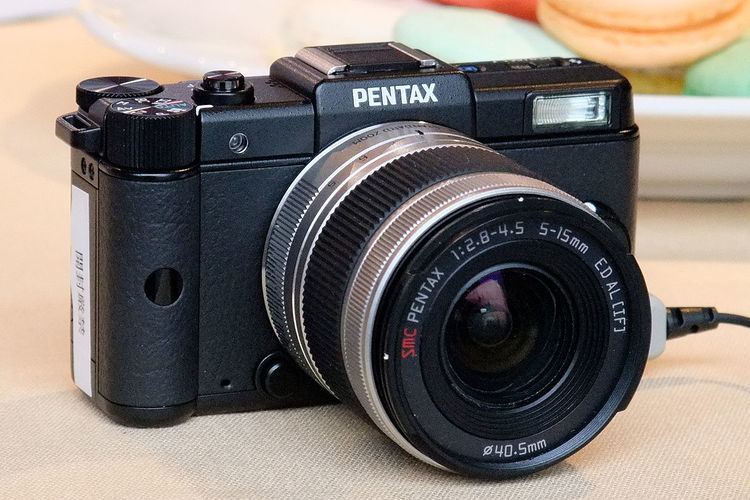Image sensor type BSI-CMOS sensor | Type Mirrorless | |
 | ||
Image sensor size 1/2.3″ (1/1.7″ for Q7 and Q-S1), 12.4 megapixel Maximum resolution 4:3 native: 4000 x 3000, 3456x2592, 2688x2016, 1920x1440 | ||
The Pentax Q is a mirrorless interchangeable-lens camera introduced by Pentax on June 23, 2011.
Characteristics
Introduced as "The world's smallest interchangeable lens system camera…" The Pentax Q system is composed of 4 bodies (Q, Q10, Q-7, Q-S1) and eight lenses: Three zooms (wide-tele, ultra-wide, telephoto), one prime "normal", and 4 "specialty" lenses (fish-eye, "toy wide", "toy tele", "mount shield lens"). The zooms and prime lenses have leaf shutters (with built-in neutral density filters) which sync with flash up to 1/2000 of a second. The other lenses (and all adapted lenses) use the camera's electronic shutter.
The camera's small sensor size (1/2.3") means that the Q has a crop factor of 5.6× (compared to full-frame 35 mm cameras), as well as a short flange focal distance (FFD). With the 5.6× crop factor, a 100 mm macro lens (for example) results in a 35 mm equivalent field of view (FOV) of a 560 mm telephoto. An additional implication of the 5.6× crop factor and associated optics is that depth of field (DOF) is increased proportionally for a given aperture setting (in comparison to the 35 mm equivalent DOF at the same aperture). This means that in some applications the small Pentax Q sensor offers an advantage over larger formats. This also allows the Pentax Q lenses to be proportionally smaller than lenses designed for larger formats.
The short FFD of the Pentax Q enables it to accept manual focus lenses from many manufacturers (via adapters) including Nikon F, Leica M and 39M, Olympus OM, Canon FD, Minolta, M42 screw mount, C-Mount, D-Mount, Pentax K, Pentax Auto 110, and Pentax 6×7.
The Pentax Q has a wide range of digital effects and controls including High Dynamic Range (HDR), multiple scene modes, and a bokeh function which, when activated, can enable a pseudo shallow focus effect.
The camera is equipped with sensor-shift image stabilization technology to improve image quality at slow shutter speeds or when using telephoto lenses. It has a "focus peaking" function as well. Sensor shift and focus peaking functions also work with adapted lenses.
The Q7 and Q-S1 models have a larger sensor size (1/1.7") resulting in a crop factor of 4.6×.
